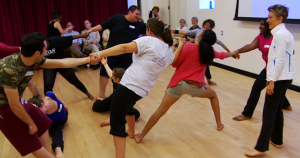University academic departments tend to work in silos. Center for the Arts Program Manager Erinn Roos-Brown explores how the arts bridge new collaborations across disciplines and inspire educational change in this entry from the ArtsFwd blog.

I recently attended the Innovations: Intersection of Art and Science symposium hosted by Wesleyan University, which explored collaborations between artists and scientists and the effects on scientific research, teaching and artmaking practices. The collaboration topics ranged from dance and biology to aesthetic choices in the evolution of bird species, and speakers came from MIT, Virginia Tech, University of Colorado, Yale University and Wesleyan, among others.While the symposium focused primarily on specific examples of collaborations, the larger question I found myself asking was: At a time when science and math education scores are staggeringly low and the goal and expense of higher education is openly questioned, how can the arts be at the core of educational change? It seems that creating deep connections between the arts and sciences at universities may be the answer.
Why should universities support these collaborations?
Alan Brown and Steven Tepper stated that interdisciplinary collaboration on college campuses “tends to be more open-ended – goals are often unclear, ambiguity is high, outcomes are unknown, and participants must develop shared language and ways of working together. Collaboration requires time, patience, openness and flexibility.”[1] So why, if these collaborations are so challenging and time consuming, is it important for a scientist to develop a dance that demonstrates genetic sequence? My takeaway from this symposium answers it in this way – our most complex global problems require multiple intelligences and can’t be solved without engaging artists, scientists, engineers and others.

Where universities have an edge is that they employ experts from so many fields and could reward the development of cross-disciplinary teams that engage research questions through exploration, experimentation and collaboration. But this isn’t the case, according to the majority of the symposium presenters. They noted that instead of focusing on collaborative research, universities have trended to be siloed – the humanities, the arts and the sciences typically stay within their own cliques. Faculty without tenure regularly decline from participating in such collaborations for fear it may affect their tenure case. Collaborations at these institutions typically only happen on the individual level and are considered “extracurricular” by the university.
Two of the presenters, MIT and Virginia Tech, had a different story. These universities have already embraced arts-centered collaborations at an institutional level. MIT recently founded the Center for Art, Science & Technology (CAST) and Virginia Tech is in the process of building a multi-million dollar art center. These technological-driven universities seem to understand the value of integrating arts into the core of their science-based curriculum. I found it particularly interesting that it was the technology schools, not the liberal arts ones, that have so quickly embraced the arts. It seemed clear to me that these schools, which benefit from new patents and products, understand that the arts serve a critical role – from promoting creative thinking to aesthetic design.
What is the role of the arts on campuses?
While there are arguably many reasons that the arts should be at the center of collaborations at universities, two points caught my attention at the symposium – the nature of the creative process in the arts and the way the arts communicate concepts.
Artists ask for the unexpected, which pushes scientific thinking during the research process. They are interested in creation, whether conceptually or via physical products, and this knowledge aids the principles of understanding for scientists. Artists are trained to take multiple ideas and perspectives, turn them into actions, evaluate failures and try again.

Artists are also skilled at communicating with audiences, an area where science is sometimes lacking. The arts express knowledge in a more universal way that connects with values, emotions and beliefs. By using these connective processes to communicate scientific knowledge, the arts can spread complex ideas to a wider audience.
How are universities uniquely positioned to foster collaborations?
These collaborations aren’t for everyone, but they would have value at every university. Universities would benefit from new ideas that challenged the current research and education models and used the faculty on campuses as resources for these collaborations. Art and science collaborations should be considered a first step, an experiment of sorts, to rethinking how we teach future generations and how we work towards solving the world’s major issues. By participating in cross-disciplinary collaborations alongside faculty, university students can be better prepared for the future. And, at the end of it all, it seems like the criticism of test scores and university education is really just about that: making sure the next generation is prepared in a way we are not.
[1] Alan S. Brown and Steven J. Tepper, Placing the Arts at the Heart of the Creative Campus: A White Paper taking stock of the Creative Campus Innovations Grant Program. December 2012.


